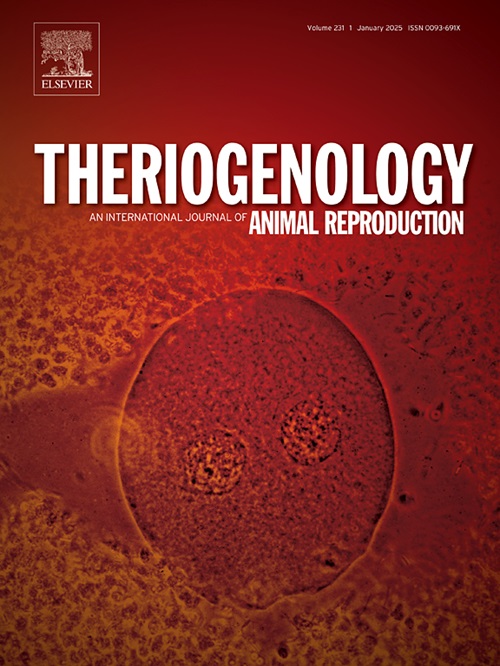在饲养场系统中饲养的青春期前母牛的生殖结果在定时人工授精治疗方案之前提交或不接受排卵诱导策略
IF 2.4
2区 农林科学
Q3 REPRODUCTIVE BIOLOGY
引用次数: 0
摘要
在人工授精(TAI)前,对未接受或未接受以黄体酮(P4)和雌二醇为基础的两种促排卵治疗方案的青春期前内洛尔(Bos indicus)母牛进行生殖结局评估。试验选取583头(11.3±1.3月龄,体重[BW] 272.2±1.6 kg)的小母牛,随机分为两组:对照组(n = 284):不处理;或2IND (n = 299):两种促排卵治疗方案。在第47天,来自2IND的小母牛接受阴道内P4装置(0.5 g),保存至第40天,然后给予0.5 mg雌二醇(EC)处理。在第19天,对来自ind的小母牛施加相同的治疗方案。在第0天,所有母牛均接受相同的TAI治疗方案,开始时使用P4装置(0.5 g),氯前列醇钠(PGF2α) 0.53 mg,苯甲酸雌二醇1.5 mg。第7天取出P4装置,给予PGF2α 0.53 mg、EC 0.5 mg、马绒毛膜促性腺激素(eCG) 200 IU。2 d后(第9天,P4装置停用后46 ~ 50 h)进行TAI,同时给予醋酸布瑟林8.4 μg。在第47天、第19天和第0天进行超声检查,评估子宫(UT)和最大卵泡(LF)直径和CL的存在;第40天检测未怀孕母牛体内CL的存在;以及在第40、70和150天(每次AI的最终妊娠[P/AI])评估P/AI和妊娠损失(PL)。采用SAS 9.4进行统计学分析(a-cP≤0.05;一个,B0.05 & lt;p≤0.10)。与0IND组相比,2ind组在第19天(73.9天和18.3%)和第0天(80.3天和32.4%)出现CL的比例更高。在第0天,0IND组犊牛的左心室直径(9.9±0.1 mm)大于2ind组犊牛(8.7±0.1 mm)。然而,在第19天(14.2±0.1和13.4±0.1 mm)和第0天(14.0±0.1和13.7±0.1 mm), 2ind处理的小母牛的UT直径都较大。与0IND组相比,2ind处理的母牛在TAI附近的行为性发情表达量更高(88.0和77.8%),尽管在第40天(39.5和41.6%)、第70天(33.1和37.7%)和最终P/AI(32.1和35.9%)以及总PL(18.6和13.6%)方面,2ind处理的母牛与0IND组母牛分别没有差异。此外,在第0天没有CL的母牛中,第2 ind组母牛的受孕率低于第0 ind组母牛(最终P/AI分别为20.3和33.9%)。无论何种治疗,第0天CL的存在和行为性发情的表达与P/AI呈正相关。无论何种治疗,体重等级(在第0天测量)积极影响LF和UT直径,以及第19天和第0天CL的存在。此外,年龄类别正影响LF和UT直径,以及CL在- 47、- 19、0和40天的存在。年龄等级对生育能力无影响,但体重等级与最终P/AI呈正相关(体重较重:39.5%A;中级:ab 33.3%;轻:29.8% b)。综上所述,尽管在TAI同步之前进行的两次促排卵处理导致第0天出现CL的母牛比例增加,促进了UT发育,改善了发情表达,但在饲养场系统中管理的青春期前Nelore母牛的生育结果并没有改善。有趣的是,对诱导排卵处理没有反应的母牛(第0天不加CL)的生殖力最低,这表明这些母牛不是处于青春期前期,而是生殖内分泌状态尚未成熟到可以诱导青春期的程度。本文章由计算机程序翻译,如有差异,请以英文原文为准。
Reproductive outcomes of prepubertal Bos indicus beef heifers raised in a feedlot system submitted or not to ovulation induction strategies prior to a timed-artificial insemination treatment regimen
Reproductive outcomes were evaluated in prepubertal Nelore (Bos indicus) heifers submitted or not to two ovulation induction treatment regimens based on progesterone (P4) and estradiol treatments prior to the timed-artificial insemination (TAI). A total of 583 heifers (11.3 ± 1.3 mo old and 272.2 ± 1.6 kg of body weight [BW]) were randomly assigned to one of two treatments: 0IND (n = 284): no treatment; or 2IND (n = 299): two ovulation induction treatment regimens. On Day −47, heifers from 2IND received an intravaginal P4 device (0.5 g), kept until Day −40, when there was treatment with 0.5 mg of estradiol cypionate (EC). On Day −19, in heifers from 2IND, the same treatment regimen was imposed. On Day 0, all heifers were submitted to the same TAI treatment regimen, starting with a P4 device (0.5 g), 0.53 mg of cloprostenol sodium (PGF2α), and 1.5 mg of estradiol benzoate. On Day 7, the P4 device was removed, and 0.53 mg of PGF2α, 0.5 mg of EC, and 200 IU of equine chorionic gonadotropin (eCG) were administered. The TAI was conducted 2 d later (Day 9, 46–50 h after P4 device withdrawal), concurrently with the administration of 8.4 μg of buserelin acetate. Ultrasound evaluations were performed on Days −47, −19 and 0 to evaluate uterine (UT) and largest follicle (LF) diameters and the presence of CL; on Day 40 to detect the presence of CL in nonpregnant heifers; and on Days 40, 70, and 150 (final pregnancy per AI [P/AI]) to assess P/AI and pregnancy losses (PL). Statistical analyses were conducted using SAS 9.4 (a-cP ≤ 0.05; A,B0.05 < P ≤ 0.10). A greater proportion of 2IND-treated heifers had CL on Days −19 (73.9 and 18.3%) and 0 (80.3 and 32.4%) compared to heifers of the 0IND group. On Day 0, the LF diameter was larger in heifers of the 0IND group than 2IND-treated heifers (9.9 ± 0.1 and 8.7 ± 0.1 mm). However, the UT diameter was larger in 2IND-treated heifers on both Days −19 (14.2 ± 0.1 and 13.4 ± 0.1 mm) and 0 (14.0 ± 0.1 and 13.7 ± 0.1 mm). The 2IND-treated heifers had greater expression of behavioral estrus near TAI compared to heifers of the 0IND group (88.0 and 77.8%), although there was no difference in P/AI on Days 40 (39.5 and 41.6%), 70 (33.1 and 37.7%) and final P/AI (32.1 and 35.9%), nor on total PL (18.6 and 13.6%), considering 2IND-treated and heifers of the 0IND group, respectively. Moreover, among heifers without CL on Day 0, 2IND-treated heifers were less fertile than heifers of the 0IND group (final P/AI: 20.3 and 33.9%). Regardless of treatment, presence of CL on Day 0 and expression of behavioral estrus were positively associated with P/AI. Regardless of treatment, BW class (measured on Day 0) positively affected LF and UT diameters, and presence of CL on Days −19 and 0. Moreover, age class positively affected LF and UT diameters, and presence of CL on Days −47, −19, 0 and 40. Age class had no effect on fertility, but BW class was positively associated with final P/AI (heavier: 39.5%A; intermediate: 33.3%AB; lighter: 29.8%B). In conclusion, although the two ovulation induction treatments imposed prior to the synchronization for TAI resulted in a larger proportion of heifers with CL on Day 0, enhanced UT development and improved expression of estrus, there was no improvement in fertility outcomes of prepubertal Nelore heifers managed in a feedlot system. Interestingly, heifers that did not respond to the ovulation induction treatments (without CL on Day 0) were least fertile, indicating that these heifers were not in a peri-pubertal state, rather, the reproductive endocrine status of these heifers was not matured to the extent puberty could be induced with the treatments imposed.
求助全文
通过发布文献求助,成功后即可免费获取论文全文。
去求助
来源期刊

Theriogenology
农林科学-生殖生物学
CiteScore
5.50
自引率
14.30%
发文量
387
审稿时长
72 days
期刊介绍:
Theriogenology provides an international forum for researchers, clinicians, and industry professionals in animal reproductive biology. This acclaimed journal publishes articles on a wide range of topics in reproductive and developmental biology, of domestic mammal, avian, and aquatic species as well as wild species which are the object of veterinary care in research or conservation programs.
 求助内容:
求助内容: 应助结果提醒方式:
应助结果提醒方式:


